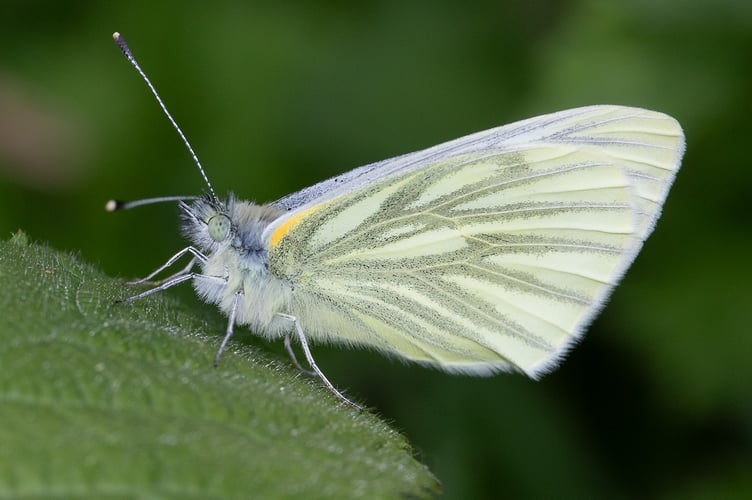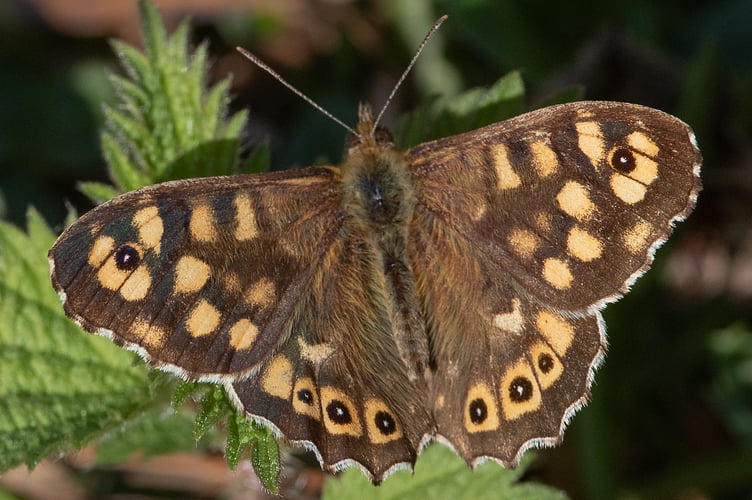This mild and largely sunny spring period seems to have worked well for the early flying butterflies. Those which have over wintered in cracks and crevices, or even garden sheds and garages, often look rather tatty when they reappear. Some are capable of erratic flight with a considerable amount of their wings missing.
Species which have freshly emerged look bright and attractive when flying in the welcomed spring sunshine like heralds of better times to come.
I often find flying butterflies are difficult to identify. Males are usually desperately flitting around in an endless search for females and rarely land for long enough to get a good view or photograph.
A few butterflies, such as male Orange-tips, are obvious even in flight; although the females are more problematic and I tend to merge them into that general category of unidentified whites. However, when settled and holding their wings upright the dark mottling on their hind wings becomes obvious.

Green-veined White butterflies are another tricky species when flying but are easily recognised by dark edged veins when settled with upright wings, particularly in the spring brood. Their caterpillars feed on wild plants such as Garlic Mustard and Lady’s Smock so they aren’t a problem to gardeners, unlike the Cabbage Whites.
Large and Small Whites can be tricky to separate even when settled and there is an overlap in sizes. When clearly seen, Large Whites have a larger and bolder dark tip to their wings but this can be reduced in the spring brood.
Both male and female Brimstone butterflies can usually be identified by their size, colour and a rather square shape in flight. Males are a bright yellow and over wintered specimens are always a welcome sight in early spring.

Males of some species can be very territorial and Speckled Wood males are particularly dedicated to defending their chosen location. I often find two males rapidly flying in tight circles and becoming just a blur while passing close to my head. Eventually one will give up on the fight and fly away while the victor settles on his particular piece of land.
Some Peacock Butterflies will over winter and they can appear during March. Identification is usually obvious due to those large blue eye shaped wing spots, although the undersides are just a bland dark area.

Other simple to recognise species which can appear during the early spring period include the Red Admiral and Comma, which gets its common name from a small white comma like mark on the wing underside. At rest, their ragged wing edges make them instantly recognisable. However, during the summer, I sometimes get confused between a flying Comma and other brown butterflies such as the Fritillaries.
Near the coast path this spring, besides seeing some Green Hairstreak males flitting around, I also found a few early Wall Butterflies. Some older books will list them as Wall Brown butterflies.
The males with dark brown edging and a central cross band on mid brown upper wings are normally easy to recognise but paler females can be confused with other brown species.
My garden has a small holly tree which usually attracts some Holly Blue butterflies but they seem to be a bit scarce so far this year. With bright blue upper sides and pale greyish blue undersides I always think their slow flight makes them appear like a flashing blue light.
The various Skipper butterflies are normally considered to be mid summer species but this year I found a Large Skipper on May 15.





Comments
This article has no comments yet. Be the first to leave a comment.